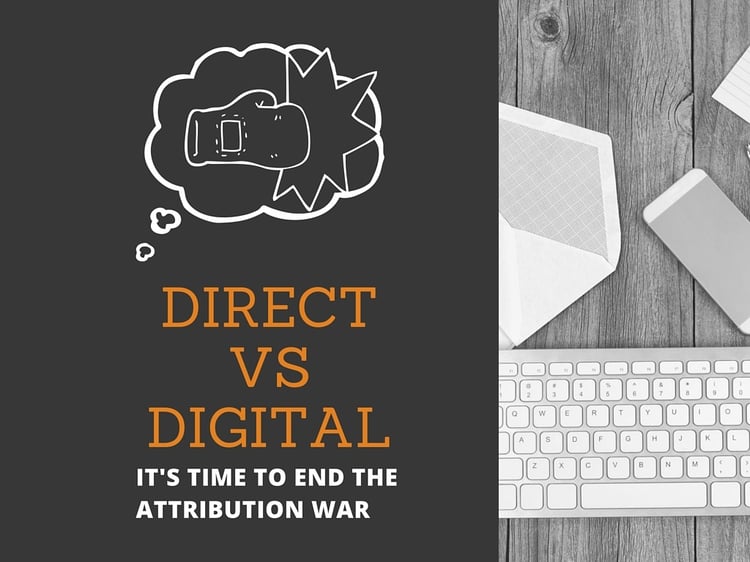
Although the various sub-divisions of marketing departments have traditionally operated in silos, consumers receive marketing messages in many ways, from what they view as a single brand entity. This insistence on dividing work, recognition and budget funding has created a fractious environment that often neglects the only goal that really matters — a satisfied, paying customer. As long as there are internal squabbles about the direct mail budget in comparison to the digital marketing budget, the company isn’t fully capable of delivering the best possible campaigns to its audience. And this disconnect can drive your audience to a company who can deliver a better customer experience across all their channels.
The war over marketing attribution has gone on too long, and marketers need to call for a cease-fire. However, doing this takes an emphasis on consumer-focused marketing. In other words, it requires all of the units of the marketing department to come together to create a new paradigm. Put the consumer ahead of the cross-departmental bickering that’s become so synonymous with marketing, and focus your energies on giving every customer and prospect the best experience possible, no matter how they choose to interact with your company. Here are a few strategies to help you put the consumer at the center of your direct marketing efforts, as well as the center of your entire company’s mission.
Download our newest offer "Transforming Data-Driven Marketing: How to Get Ready for the Digital to Print Revolution" to see how data is driving direct mail success.
A Top-Down Consumer Focus
If the endgame of any marketing plan is to increase revenues, why is the methodology for each division’s part of the campaign devised separately? If the left hand of your company doesn’t know what the right is doing, how can you ever expect to hit the right notes with your audience?
And yet, this is what happens in companies all over the world. A customer might receive a direct mail piece and make a purchase as a result. However, if they don’t use the specific code or URL provided in the direct mail piece, the direct mail team doesn’t get the appropriate credit, potentially resulting in decreased stature within the company and a reduced direct mail budget.
Instead of encouraging this culture in which marketers fight for attribution, companies should change their focus to the consumer. Providing a customer experience that results in each individual customer and prospect having their unique needs met at each opportunity will create a loyal audience of brand advocates. Their enthusiasm will reach others in a way that no marketing campaign could even hope to.
This change must incorporate all areas of your company’s marketing. But more importantly, it has to start from the top. If your employees continue to focus on who gets the credit for which sale, they’ll never truly be able to focus on the customer. But getting everyone on board for this type of organizational change takes work. Focus on areas marketers and the C-suite have in common, like budget constraints and measuring performance. Focusing on the customer, or audience segment, rather than the media you are trying to reach them with will improve the overall customer experience, which leads to higher ROI.
Open Communication
Modern-day marketing is all about acquiring information about customers and prospects and using that data to improve the overall consumer experience. The problem is, the fragmented nature of many marketing departments means that each unit doesn’t get to access the information retrieved by the other sub-divisions. Not only does this result in an incomplete picture being painted of each consumer, but it also means that your marketing department might be doing the same job multiple times.
For example, the focus of inbound marketing is creating an effective buyer persona and using that to identify potential customers; and speaking to those consumers in the language and manner they’re most likely to respond to. It’s a model that works great in most cases. But why limit this model to inbound marketing? Direct mail marketers also use similar methods of segmentation and the application of intent data to make the best possible pitch to the audience segment that are most relevant to a given offer. However, the direct mail team is left to its own devices to execute their strategy. Why is the direct mail staff limited only to information related to their previous mailers, when they could benefit from knowing how customers interact online, even if the customer doesn’t make a purchase right away?
This is just one of the many ways the different arms of the marketing team can work with each other. The key element is the presence — and encouragement — of valuable communication between units. While revenue is your ultimate goal, data is the currency that will get you to your destination. It only makes sense that the data acquired by your marketing teams be accessible to all areas of your marketing operation. And data from your sales teams, customer service and many other departments within your company is integrated for open, and seamless, communication at all levels.
Consider the growing trend of agreements between sales and inbound marketing departments, two groups with famously negative feelings towards each other. The two sides are beginning to realize there’s a lot they can learn from each other, and companies have encouraged the teams to develop better working relationships. Clearing the air regarding the responsibilities of each unit has helped a great deal, but what’s been even more effective is the communal use of data among sales and marketing. Centralizing this data has helped each side to fill in the blanks in their respective duties, making the new-found partnership between marketing and sales a productive and healthy one.
The same sentiment applies to the disconnect between digital marketing and direct mail. Rather than being pitted against each other, the two sides should work together to create the best campaigns possible. Given the resources and data that would be shared in this endeavor — not to mention the fact that both groups carry out similar functions through different mediums — such a relationship would be easier to develop than you might think.
Integrated Campaign Planning by Audience Segment
Because of the fragmented nature of marketing, it’s possible to unwittingly bombard the customer to the point of alienation. It’s not out of the ordinary for an individual to receive emails, catalogs, letters, social media promotions and banner ads from the same company, all within the same day, even within minutes of each other. Running separate digital and print campaigns unrelated to each other is a waste of resources and a major risk of turning away your customers with too much advertising.
And having digital marketing and direct mail running against each other is counter-intuitive. The ideal solution is to align these two resources as one. After all, both groups use intent data to target customers and appeal to specific demographics. Instead of dividing your print and digital efforts to reach the same consumers, marketing should be structured to reach the audience segment across all effective media channels for that segment. The goal is to create a seamless customer experience that leads your customer to purchase. Whether it was a print, email or digital display ad is irrelevant. Consumers no longer rely on one linear path before they purchase. And your marketing efforts can’t rely on isolated channels to guide a customer along their path.
Consumer-Focused Marketing
The idea of combining resources is nothing new, but it might come as a shock to people used to the traditional methods of marketing attribution. However, every marketing team should have bigger goals than to increase their internal numbers and to bolster their annual budgets. The direct mail budget isn’t as important as how direct mail works with the other elements of a marketing campaign. Furthermore, pooling all of the data collected about each customer and prospect will help all areas of a marketing department. When the attribution war is over, marketing can then focus all of its energies on the customer. And when the customer wins, every aspect of the company wins as well.


Lookalike Audiences Enhance customer acquisition by identifying high-potential prospects, boosting response rates, and lowering advertising costs.
Retargeting Postcards Double the performance of your direct mail retargeting.
Amplify Recognize unknown visitors who are actually customers. Add 20-40% to your ESP/CRM campaigns.
IQ Mail Retain customers with personalized, timely messages for those opting out of digital channels.







Comments